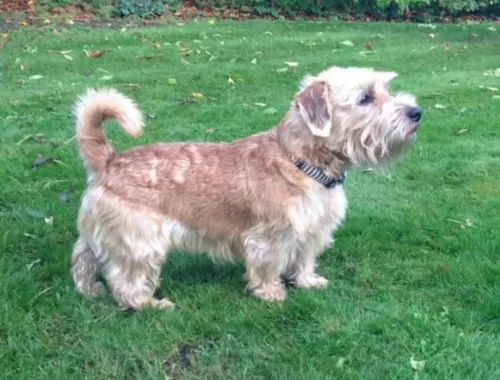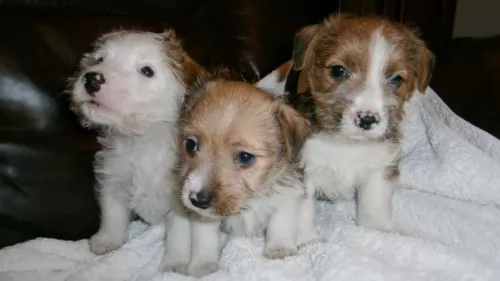 Petzlover
PetzloverBoth Lucas Terrier and Old English Terrier are originated from United Kingdom. Lucas Terrier may grow 15 cm / 5 inches shorter than Old English Terrier. Lucas Terrier may weigh 6 kg / 13 pounds lesser than Old English Terrier. Lucas Terrier may live 3 years more than Old English Terrier. Lucas Terrier may have less litter size than Old English Terrier. Both Lucas Terrier and Old English Terrier requires Moderate Maintenance.
 The Lucas Terrier is a rare breed which hails from England, originating there in the late 1940s. Today it is considered a purebred. It was originally a hybrid dog, bred by crossing a Norfolk Terrier with a Sealyham Terrier.
The Lucas Terrier is a rare breed which hails from England, originating there in the late 1940s. Today it is considered a purebred. It was originally a hybrid dog, bred by crossing a Norfolk Terrier with a Sealyham Terrier.
Sir Lucas felt that the Sealyham Terrier was a bit too big for his purpose so he crossed the Sealyham with Norfolk Terriers to bring about the Lucas Terrier. The Lucas Terrier is a dog which is essentially bred for temperament and companionship and is therefore not aggressive.
The Lucas Terrier has been in the United States of America since the late 1960s and is considered a rare breed.The Lucas Terrier Club is a private, informally run organisation developed to both preserve and promote this dog breed.
Known also as the Black Terrier, by the 18th century, the Old English Terrier was available as a rough-coated dog as well as a smooth-coated dog.
The dogs were established in England. The dog was developed to work and by the 19th century the Old English Terrier was to be found all over the world.
The dog was developed based on the work it was required to do, leading to variations in the coat texture, the body and size. The Old English Terrier is recognized today by the National Terriers Club LLC.
 The sweet Lucas Terrier is a small dog breed that stands at between 25 – 30cm in height and weighs anything between 5 – 9 kg.
The sweet Lucas Terrier is a small dog breed that stands at between 25 – 30cm in height and weighs anything between 5 – 9 kg.
The chest of the dog is deep and low, the nose black, the eyes dark and almond shaped, the ears medium sized and floppy. The tail is traditionally docked, giving the dog an attractive, solid, compact look to it.
If you want your Lucas Terrier to become a parent, you can expect between 3 to 5 of the cutest little puppies. Spaying and neutering are an excellent idea health-wise if you don’t want your terrier dog to have puppies.
The weather-resistant coat of the Lucas Terrier is fairly harsh and is of medium length. While most Lucas Terriers are fawnish, cream, grey or black and tan, you also get a white one.
He does great with training and socialization and is an adaptable dog too, being happy to settle into life in the city or the countryside.
This is such a sweet, amicable, jaunty little dog, good with kids and always ready for a game. With socialization and training he is ready to get on well with everyone, as well as with other dogs in the house. It is no wonder that he is becoming so popular – he just gets on with everyone, and is eager to please.
The Lucas Terrier is generally well behaved as well and being quiet, gentle and calm indoors. Because he is a Terrier, he likes to bark quite a bit, but training and socialization can help with that. Training won’t be difficult as he is intelligent.
The Old English Terrier is a working dog, a sporting terrier known for his athleticism. This is a vibrant dog, both physically and mentally, and the dog will require plenty of physical exercise as well as mental stimulation.
If you go to a reputable pet shop, you will find many stimulating toys for such a clever dog. He is also social and friendly and makes a wonderful pet.
Your Old English Terrier stands at between 30 – 45cm and weighs between 6 and 15kg. The face of the dog is wedge-shaped and the eyes are set wide apart. The ears are erect and the tail has been docked but is left long these days.
The coat of the dog can be either rough or smooth and it is available in solid black or white or a black and tan mix.
The Old English Terrier is a working and sporting terrier. He makes a wonderful companion pet. He is an intelligent, boisterous type of dog and early training and socialization are necessary to make him obedient and more amicable around people and pets.
They are loving with their human family, but because they require such vigorous exercise, they are better suited to life in the countryside as opposed to living in a cramped space in the city.
 Lively, playful, social and animated – the Lucas Terrier is such a pleasure to have around and will bring joy into your home. He is full of enthusiasm and will always be ready for a game or for a walk.
Lively, playful, social and animated – the Lucas Terrier is such a pleasure to have around and will bring joy into your home. He is full of enthusiasm and will always be ready for a game or for a walk.
They are dogs who just love being around their human family, forming close bonds with them. They’re adaptable too and slot into different situations with ease.
Gentle, calm and obedient, once you let one of these sweet dogs into your home and heart, you’ll never want to be without such a loving friend again.
Your Old English Terrier is a working dog and while he is known to be independent and sometimes quite stubborn, he is intelligent and trainable.
He should be trained and socialized and then he becomes a great family pet, being amicable with children and other pets. He is a good natured pet but he has lots of energy and will rely on you to provide him with walks and games, whether you live in the city or the countryside.
Give him the right upbringing and you can be assured of the most splendid pet and companion.
 Your Lucas Terrier is such a robust, jaunty, feisty little dog and with excellent care from you he may be able to push two decades. With a healthy diet and exercise, you shouldn’t have to be at the vet often with this dog.
Your Lucas Terrier is such a robust, jaunty, feisty little dog and with excellent care from you he may be able to push two decades. With a healthy diet and exercise, you shouldn’t have to be at the vet often with this dog.
There are however, always common dog illnesses that even the most healthy dog can succumb to – ear infections, eye infections, bloat, cancer, hip dysplasia and others.
Skin problems may seem mild, but they can bring a whole lot of frustration and pain to your pet. You’ve got to be careful because sometimes skin problems may be indicative of other health issues. Probably the most common cause of skin problems in dogs are allergies from parasites like fleas.
Bacterial skin infections are caused when your pet is bitten by a flea for instance and then he scratches and licks, breaking the skin and bacteria gets in, infecting the wound.
Yeast infections for instance could be found in the ear canal and around the anus. Infections like this occur in damp areas and also when other conditions are right. Yeast infections cause itchy skin with hair loss.
Skin infections are not to be taken lightly. They can bring a whole lot of discomfort to your pet and you will most certainly need to get him to the vet.
There are some health problems with a dog that can be inherited, but some illnesses develop because of bad lifestyle and bad diet along with lack of exercise.
Your Old English Terrier can live to anything from 10 to 14 years of age, but there are always some common dog diseases that you may want to be aware of.
Dental disease, skin allergies, hip dysplasia, cancer, epilepsy, bloat and eye diseases are just some of the diseases that are highly unlikely, but which can be worrisome for your pet.
 This little dog isn’t a high energy dog but he will need to have a daily walk over and above the games you provide him with. Giving him a walk will be stimulating for him too as it gives him the chance to see different things and sniff around a bit.
This little dog isn’t a high energy dog but he will need to have a daily walk over and above the games you provide him with. Giving him a walk will be stimulating for him too as it gives him the chance to see different things and sniff around a bit.
The Lucas Terrier is looked upon as a low maintenance breed and a low shedder. You will need to brush him twice a week to keep the coat lustrous and to remove loose hair. Hand stripping is a method used for grooming his double coat but some people prefer to have him professionally clipped.
Feeding a dog should be a simple affair. All dog breeds appreciate a simple but nutritious diet as this avoids digestive problems.
The Lucas Terrier relies on quality food full of vitamins and minerals to ensure his health and longevity. True, commercially manufactured foods aren’t a wonderful choice, but there are some good ones and they do offer a tremendous amount of convenience.
However, you don’t just want to put a bowl of dry kibble in front of your pet night after night, so to add some tasty variety, boil chicken and brown rice or pasta along with some cooked or raw vegetables and add this to his dry kibble from time to time. It makes like a delicious kind of stew to add to the dry kibble.
You’ll see, your Lucas Terrier will have bright eyes, a wet nose and a wagging tail. He’ll thank you for sticking to a simple style of feeding that doesn’t come with unpleasant surprises to upset his stomach. Make sure he always has a bowl of fresh cool water constantly available.
Looking after your Old English Terrier is easy, whether you choose the short- or long haired breed, requiring you to brush him twice a week to remove those loose hairs. Check in and outside the ears for ticks and fleas and check around the eyes for infections.
Always run your hands over your dog to make sure there are no unusual lumps which could be indicative of cancer.
Make sure your pet has a nice dry, warm place to sleep, and if he is outdoors, make sure he has a spot to lie down in that is out of the sun and rain.
He is an active dog and will require a walk each day as well as ball- and rope games.
Every dog will benefit from a high quality diet, both commercially manufactured food and home-made food. Dogs want their meals to be simple, tasty, consistent and delicious.
Dry kibble needs to be of a high quality and you can add in simple home-made food to his kibble and which is simple – boiled chicken, brown rice or pasta and vegetables such as spinach, sweet potatoes and carrots. When you can afford it, some raw meat added into the kibble will be a welcome treat.
Such a simple diet will ensure you don’t battle with your dog’s digestion and it will keep him bright-eyed and healthy. Ensure a constant supply of fresh, cool water.